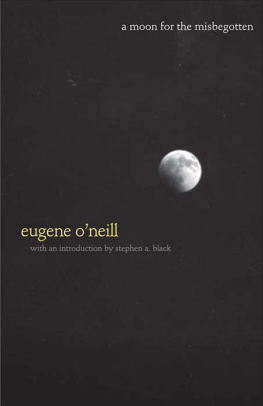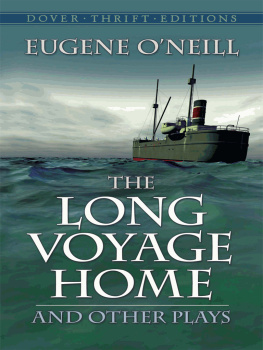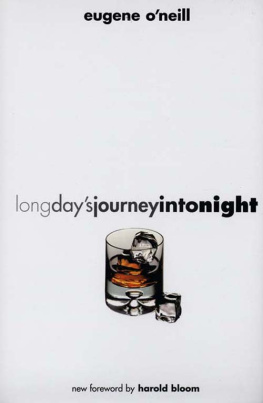Eugene ONeill - A moon for the misbegotten
Here you can read online Eugene ONeill - A moon for the misbegotten full text of the book (entire story) in english for free. Download pdf and epub, get meaning, cover and reviews about this ebook. City: New Haven, CT, Connecticut, year: 2006, publisher: Yale University Press, genre: Art. Description of the work, (preface) as well as reviews are available. Best literature library LitArk.com created for fans of good reading and offers a wide selection of genres:
Romance novel
Science fiction
Adventure
Detective
Science
History
Home and family
Prose
Art
Politics
Computer
Non-fiction
Religion
Business
Children
Humor
Choose a favorite category and find really read worthwhile books. Enjoy immersion in the world of imagination, feel the emotions of the characters or learn something new for yourself, make an fascinating discovery.
- Book:A moon for the misbegotten
- Author:
- Publisher:Yale University Press
- Genre:
- Year:2006
- City:New Haven, CT, Connecticut
- Rating:5 / 5
- Favourites:Add to favourites
- Your mark:
- 100
- 1
- 2
- 3
- 4
- 5
A moon for the misbegotten: summary, description and annotation
We offer to read an annotation, description, summary or preface (depends on what the author of the book "A moon for the misbegotten" wrote himself). If you haven't found the necessary information about the book — write in the comments, we will try to find it.
A moon for the misbegotten — read online for free the complete book (whole text) full work
Below is the text of the book, divided by pages. System saving the place of the last page read, allows you to conveniently read the book "A moon for the misbegotten" online for free, without having to search again every time where you left off. Put a bookmark, and you can go to the page where you finished reading at any time.
Font size:
Interval:
Bookmark:
A Moon for the Misbegotten
Misbegotten
Stephen A. Black
 YALE NOTA BENE
YALE NOTA BENEYale University Press New Haven and London First published as a Yale Nota Bene book in 2006.
Copyright as an unpublished work by Eugene ONeill 1945; copyright renewed by Shane ONeill and Oona ONeill Chaplin 1973. Copyright 1952 by Eugene ONeill Copyright renewed 1980 by Oona ONeill Chaplin. Introduction 2006 by Yale University. All rights reserved. S. S.
Copyright Law and except by reviewers for the public press), without written permission from the publishers.
For information about this and other Yale University Press publications, please contact: U.S. office sales.press@yale.edu Europe office sales@yaleup.co.uk
Set in Garamond type by Tseng Information Systems, Inc. Printed in the United States of America.
Library of Congress Control Number: 2006903366 ISBN-13: 978-0-300-11815-5 ISBN-10: 0-300-11815-5
A catalogue record for this book is available from the British Library.
10 9 8 7 6 5 4 3 2 1 CAUTION: Professionals and amateurs are hereby warned that A Moon for the Misbegotten, being fully protected under the copyright laws of the United States of America, the British Commonwealth, including Canada, and all other countries of the copyright union, is subject to royalties. All rights, including professional and amateur performance, motion picture, recitation, public reading, radio broadcasting, and the rights of translation into foreign languages are strictly reserved. All inquiries regarding production rights to this play should be addressed to William Morris Agency, Inc., 1325 Avenue of the Americas, New York, NY 10019, Attn. Samuel Liff.
All other inquiries should be addressed to Yale University, Office of the General Counsel, P.O. Box 208255, New Haven, CT 06520-8255, or to Herbert P. Jacoby, Lacher & Lovell Taylor, 750 Lexington Ave., New York, NY 10022.
Introduction Eugene ONeill and A Moon for the Misbegotten STEPHEN A. BLACK Of ONeills major plays, the two most often performed and most often read by the general public and in English or drama courses are probably Long Days Journey into Night and its sequel, A Moon for the Misbegotten. Moon took much longer to have its great value acknowledged and to find its place among ONeills plays and in the canon of American drama. Moon took much longer to have its great value acknowledged and to find its place among ONeills plays and in the canon of American drama.
The Theatre Guild attempted a production in 1947, which closed after trial performances in Columbus, St. Louis, and Detroit (where censors wanted to close the play for blasphemy), and it was not performed in the United States again until 1957 (although a fairly successful production played in Belfast and Dublin in 1954). It is not surprising that Long Days Journey was so quickly accepted, because of the well-publicized knowledge that ONeill had tried to ensure that the play would never be performed, and never be published in his lifetime. ONeills efforts implied that the intimate details of family life with a mother addicted to morphine were scandalously true, and that the story revealed much about the personal life of a playwright who had done his best throughout his life to guard his privacy. That Journey was a great play was also immediately visible. Moon is a different and much more difficult play to grasp. Moon is a different and much more difficult play to grasp.
It begins as a broad comedy of rough country manners, and then transforms into the somber story of a man compulsively telling a young woman, a reluctant listener, of his behaviorbehavior he can neither forget nor forgive himselfwhile his mother was dying in Los Angeles, and while he accompanied her body on the train to New York. The man is called Jim Tyrone and is the same character as the older brother in Long Days Journey. The story is set eleven years after the time of Journey, a few weeks before the actual James ONeill, Jr., the playwrights older brother, died in a private asylum from prolonged alcohol poisoning. Moon is a kind of sequel to Long Days Journey, but the connection would not be apparent for another nine years because even the existence, let alone the story, of Journey would not be known until 1956, long after Moon had its unsuccessful 1947 tryout. The years immediately after World War II were not propitious for long, somber, tragic plays. Journey won immediate recognition. Journey won immediate recognition.
Its New York opening, directed by Jos Quintero, with Frederick March, Florence Eldridge, Jason Robards, Bradford Dillman, and Kathleen Ross, worked wonderfully, holding audiences spellbound for its full four-hour length and sending them from theaters with that mixture of somberness and elation that lets us know we have had an experience that has in some way changed our lives. Moon has had a quite different history. The plays progression from amusing to disturbing led at first to some confused productions and audiences. After several productions in America and the British Isles, the play finally began to come into its own and to seem coherent because of a production in 1973, directed by Quintero and starring Jason Robards as Jim Tyrone. Robards, who had played the older brother, Jamie, in Journey, was now playing a Jamie eleven years older. Unable to mourn and begin the letting go that must happen after a death, unable to stop thinking about his dead father and mother, cut off from his brother, Jamie was much further gone in alcoholism and despair than ever before.
In Colleen Dewhurst, the role of Josie had a gifted actress who was approximately the size and appearance ONeill specified for the other main character. Ed Flanders played Phil Hogan. The production, filmed for television with the same actors and broadcast by ABC in 1975, is available to educational institutions and has become widely known. It seems likely that ONeill would have been satisfied with the productionto the degree he was ever satisfied with any of his plays on stageand many ONeill scholars and enthusiasts think of it as the definitive production. It has surely been a source of emulation as well as imitation for directors and actors who put on the play. That may be a mixed blessing for many reasons, only one of which is that no one else can be Mr.
Robards or Ms. Dewhurst. It is possible that the influence of the Quintero-Robards-Dewhurst production has inhibited directors and actors from exploring some of the plays possibilities. An ONeill scholar and man of the theater, Paul Voelker, who had seen Robards and Dewhurst only in the television version, wrote in 1978, with perhaps a little exaggeration, that simply because Robards is Robards, Jim Tyrone becomes the most important character in the play, when he should not be even the second most important. Voelker felt that simply casting Robards as Tyrone gave the part such weight, emphasizing so very strongly Jims self-loathing as he described his misbehavior with the prostitute on the train, that it overbalanced the play and reduced it to little more than an autobiographical document. Voelker is surely correct when he writes that Jims confessional speech is no more important than JosieS reaction to it, although I think there is much more to say on the point.
I believe that understanding Jim enables Josie finally to acknowledge a desire for love from a man she can admire, a desire that she has denied herself because she takes for granted that she is unattractive and because she gets a good deal of satisfaction from her life of working the farm, being housekeeper and almost a wife to her father, and being co-prankster in his schemes and practical jokes. When she is forced to listen to Jim in acts 3 and 4, he makes her understand what she doesnt want to know: that Jim really means it, and really understands what he says, when he repeatedly tells her that he is dead. Josie has insisted (as the audience is likely to do at first) on interpreting the words to mean, perhaps, that he feels like hell or has a terrible hangover. She must now understand that Jim is emotionally dead, even if he will continue to breathe for a little while longer, that he is incapable of giving her the kind of love that she has finally admitted to herself she needs and wantsthe kind she cant get from a father, no matter how much he loves her and no matter how much fun they get from their jokes and games. And so one can say that the play ends with a loss, the loss by Josie of her comforting back-of-the-mind assumption that she loves Jim Tyrone and he might be made to love her sometime if things get rocky enough for him that he needs a soft, womanly bosom to weep on. Her father has held a slightly different notion for some time, that if he can catch Jim at just the right moment, a moment like tonight, say, when hes blue and the heebie-jeebies are after him, that perhaps Jim might see how fine JosieS qualities are, that she might even make him happy for a while, or as happy as he can be, and that he might even wander into marrying her.
Next pageFont size:
Interval:
Bookmark:
Similar books «A moon for the misbegotten»
Look at similar books to A moon for the misbegotten. We have selected literature similar in name and meaning in the hope of providing readers with more options to find new, interesting, not yet read works.
Discussion, reviews of the book A moon for the misbegotten and just readers' own opinions. Leave your comments, write what you think about the work, its meaning or the main characters. Specify what exactly you liked and what you didn't like, and why you think so.




